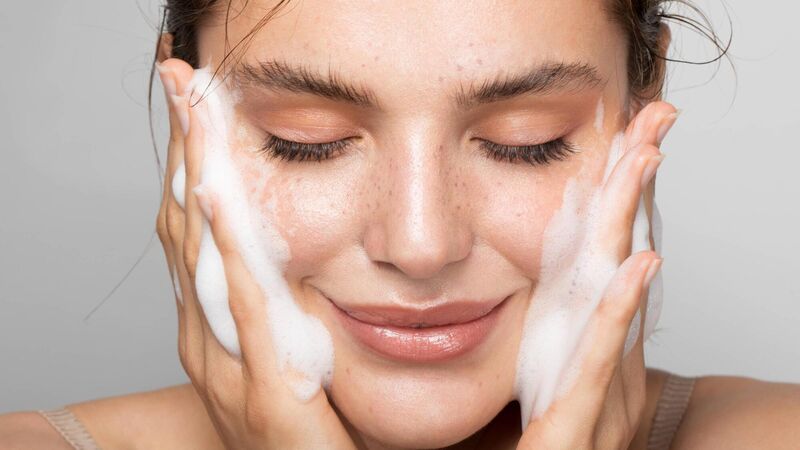The Skin Nerd: How to build a better skincare routine

The Skin Nerd: How to build a better skincare routine
How do I create a good skincare regime?
It is one of the questions I get asked the most – and whilst the answer can be tailored to suit your skin goal, the fundamentals of building an effective skincare regime always revolve around a small number of core steps.
A good skincare routine should always involve a three-pronged 360 approach: inside (diet, supplements, mindset), outside (skincare) and on top (SPF and makeup).
Whilst TikTok can have you believing that dozens of complicated steps are a daily necessity, what your skin actually needs every day can be simplified to just three or four, which is why at The Skin Nerd we recommend a daily regime built around:
- a nourishing cleanser
- a serum for concentrated hydration
- an SPF for essential protection
Anything you add on top will then be down to your specific skin type but could include an active treatment cleanser that should be used no more than every 2/3 nights and a barrier-boosting moisturiser to be used as and when needed.
So, these are the non-negotiables but to be effective, you still need to take care with each step and be consistent for optimal skin health – and here’s how.
Cleansing plays an imperative role in skin health and is key in preparing your skin for the rest of your routine, creating a clean, receptive slate for your active ingredients and any hydrators that follow.
When possible, I believe everyone should double cleanse.
Double cleansing is beneficial because the first cleanse works to remove any oil, makeup, dirt, debris, and SPF that’s gathered on your face during the day.
It degreases the skin so that your follow-up, second cleanse is able to cleanse your clean skin and is, therefore, more likely to successfully address the skin condition or goal that you are trying to target.
The type of cleanser you use matters too.
It’s not necessary to spend heaps on a cleanser but do make sure that your twice-daily cleanser is a pacifying, nourishing one.
This means that it cleanses the skin thoroughly but is kind on the skin barrier by gently removing makeup, oil, pollutants, and SPF without upsetting the skin’s pH balance.
Remember a cleanser shouldn’t just ‘take’ from the skin but should also provide nourishment and any necessary actives to prep the skin for the next steps.
Something gentle like IMAGE Ormedic Balancing Facial Cleanser (€38, theskinnerd.com) is suitable for all skin types and contains a balancing blend of soothing aloe vera and moisture-replenishing hyaluronic acid.
Active cleansers can be used up to 2-3 times a week, preferably in the evening and aim to address a specific goal (other than simply getting your skin clean).
Active cleansers include those containing salicylic acid for managing congestion and balancing oil, and exfoliating acids including glycolic or lactic acid to brighten lacklustre skin.
How often should you cleanse? Whilst not cleansing enough can lead to congestion which can then lead to acne, it isn’t necessary to cleanse more than twice a day (unless you have been sweating lots during the day).
One last takeaway when it comes to washing your face - using facial wipes is a big no-no!
Whilst they seem like an easy solution when you are desperate to get to bed, wipes do not clean thoroughly, leaving your pores clogged and primed for a breakout.
They can also strip and dehydrate the skin, causing redness and irritation!
The Cleanse Off Mitt (€6.50, skingredients.com) is a just as easy pre-cleanse alternative and removes makeup with just water. Plus, it can be washed and reused, so is a more sustainable choice!
Now that we have a freshly cleaned slate (face), it’s time to hydrate!
As serums are the most concentrated method of delivering active ingredients to the lower levels of the skin, I always recommend investing in one or two over a pricey moisturiser that is unlikely to contain actives and therefore less likely to play a big part in achieving the results that you desire.
This is the part of your regime that the biggest portion of your budget should be dedicated to and so it is important to select your serum wisely, based on the ingredients included and the goals you have in mind for your skin.
Many serums are multi-purpose, meaning that they can target a few concerns simultaneously.
Personally, I always include serums containing hyaluronic acid for hydration, vitamin A to re-educate the skin and vitamins E and C for antioxidant protection.
With a HUGE list of merits, Vitamin A is the most-evidence-supported topical ingredient for reducing the visible signs of ageing and therefore formulas including this ingredient can make a visible difference to your skin.
If you are a vitamin A newbie, I always recommend beginning with retinyl palmitate.
Retinyl palmitate is the fatty form of vitamin A and needs to be converted into retinoic acid by the skin.
This process slightly reduces vitamin A’s efficacy but as it is less potent, it helps to prevent skin irritation.
Slow and steady is the only way to go on your vitamin A journey – you need to progressively build up your skin’s tolerance as overuse can lead to irritation and flaking, otherwise known as a ‘retinoid response.’
Like cleansing, serums are usually designed for twice-a-day application and should be applied after cleansing to dampened skin.
I am sure the fact that you need to apply SPF 365 days a year lives rent-free in your mind by now but for those of you who need reminding, SPF is the final and most important part of your skincare regime.
Not only does sunscreen work to protect you from potentially cancer-causing UV rays, but it also helps to slow the speed of ageing – for which the sun is 80% responsible!
Along with triggering pigmentation and fine lines, prolonged UV exposure can degrade collagen and elastin - two structural proteins responsible for the skin ‘snapback-ability.’
Take action with the consistent application of SPF – that's every single day, with 2-hourly re-applications during the day as advised by the Irish Cancer Society.
Thankfully, sunscreen has progressed massively from the thick, Casper-white formulas of yesteryear, with non-comedogenic options, ones that leave a brightening glow and ones you can apply over makeup, so there are no excuses when it comes to being proactive with protection.
In general, the use of a separate eye cream is not necessary if you have a serum or facial moisturiser that is safe for use under the eyes.
To be safe for use around the eye area, a product will explicitly say so or will say ‘ocular tested.’
That being said, if you have tried using your facial serum and are seeking additional results, you could try adding a caffeine-infused eye product to target dark circles or one enriched with vitamins A and C and peptides for a brightening boost.










